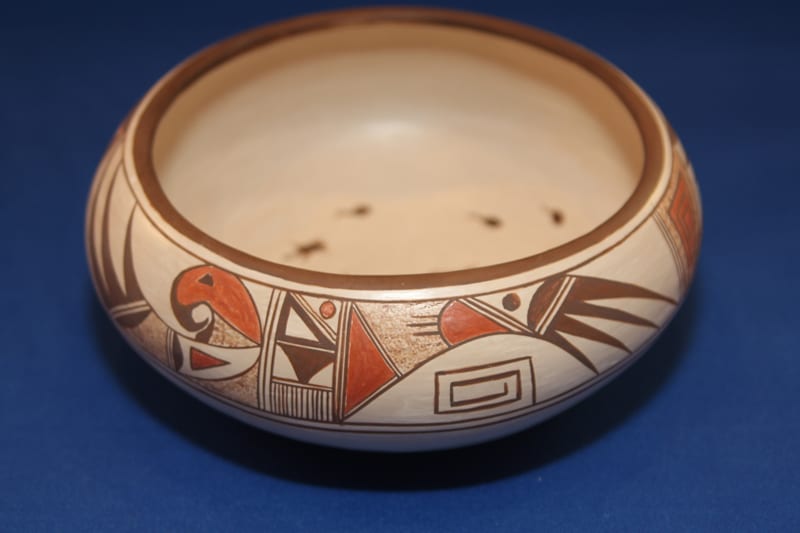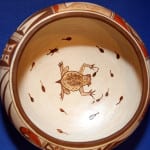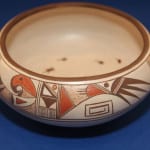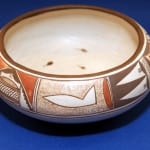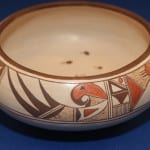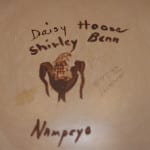“This beautiful bowl was potted by Daisy and painted by her daughter Shirley Benn. The outside is painted with traditional Nampeyo family designs, but the inside of the bowl features a frog surrounded by tadpoles, one of which is well on his way to becoming a frog. It is a delightful, humorous bowl.” –comments by Rutt Bridges, the original owner.
Bowl 2010-25 was probably made circa 1988 and has a pedigree similar to pot 2007-02 in the collection. Both are made of Zuni clay and formed by Daisy Hooee Nampeyo. Both seem to be kiln-fired. Both have Hopi iconography on the exterior, though pot 2007-02 was apparently painted by Daisy and the painting on bowl 2010-25 was done by her daughter, Shirley Benn. Daisy had a particularly diverse life, with artistic roots at Hopi, Paris (France) and Zuni. Bowl 2010-25 displays this rich heritage in its second generation: daughter Shirley has used Hopi designs on the exterior and a Zuni motif on the interior. Shirley is Hopi/Tewa through her mother’s matriarchal line. I’m not sure where she was born (in 1936), but she was apparently living at Zuni by the time she was 19 years old (Schaaf 1998:116).
Shirley is well known as a jeweler and makes pottery only infrequently. Her training is apparent in her careful, confident design. The exterior of bowl 2010-25 displays a variety of (mostly) traditional Hopi/Tewa motifs: a semi-realistic bird, a “migration wing” element, avian and water symbols and a four-pane “window” element that was frequently used by Nampeyo. This latter design is outlined in red, an unusual touch. In addition there is a red, black and stippled design that looks like the end view of a bed (or a Big Mac), a design element that I have not seen before.
Unlike a typical Hopi or Hopi/Tewa bowl, the design elements are not repeated in a balanced format but are seen only once on bowl 2010-25.
While the interior design is said to center around a frog, the design is probably a spadefoot toad:
———-
This little animal lives through dry spells (in the Southwest) in a state of estivation under the dried-up sediment in the bottom of a hole. When the rain comes, if it comes, he emerges from the mud singing madly…mates…and fills the pool with a swarm of tadpoles, most of them doomed to the most ephemeral existence. But a few survive, mature, and become real toads, and when the pool dries up they dig into the sediment as their parents did before. (Edward Abbey in O’Reilly 2001:87-88)
———-
The interior design shows 15 newly-hatched tadpoles and one small tadpole that is metamorphosing into a toad. These cluster around a large toad that is almost fully-formed, except for the remnant of a tail. Frogs and toads are more frequents depicted on Zuni than Hopi pottery, but the celebration and prayer for rain is similar in both cultures. (For a Hopi pot with appliqué Zuni frogs by Daisy, see pot 2011-13.)
A pot with an almost identical interior and perhaps a similar exterior (it’s hard to see) is illustrated by the Blairs in their book about Nampeyo and is part of the authors’ collection:
———-
“In this joint work by Daisy and Shirley, (the) decoration is a unique combination of Zuni and Hopi-Tewa design. The interior is decorated with typical Zuni frogs and tadpoles, while the exterior has a band of elements bordered by unbroken cloud bands. The bowl was made in 1988, late in Daisy’s professional life, and (is) signed ‘Daisy H. Nampeyo and Shirley Benn’ (1999:color portfolio XX:fig 4.23).
———-
This pot is one of a group of pots that were part of a 2,400-item Southwest pueblo pottery collection that was assembled by Rutt Bridges of Denver, CO over a period of about 14 years. His sister, Kathleen Hoff, is helping her brother sell the collection. In 2009 Kat sent me two CDs with information about Hopi pots in the collection. During 2010, over a period of months Kay sent me additional photographs of about 200 Hopi and Hopi/Tewa pots from the collection.

